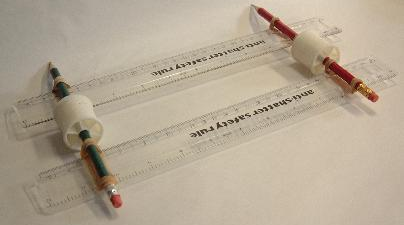Make your own robot
A simple robot to make, plus robots in everyday life to investigate.
Project
What is a robot? Robotic devices are anything which we make to take over a job which is boring, repetitive or dangerous to humans. Start by doing a 'robot walk' round your classroom - what can you see which has been invented by humans to make life easier, quicker or safer?
You can make a simple robot from everyday materials.
Equipment needed:
- two pencils
- two rulers
- two cotton reels
- rubber bands
- one electric motor
- one battery holder
Making your robot
Stage 1: if you are using long rubber bands, double them up; if you are using small ones, use several.

Stage 2: the rubber bands need to provide a firm fixing, so they need to be tight.

Stage 3: use the rubber band fixing technique to construct a basic unit that looks like the one below.

Stage 4: attach the electric motor and battery holder with blu-tak or plasticene. The rubber drive band to the cotton reel needs to be only slightly tight.

Stage 5: when the electric motor is connected to the battery, the cotton reel should rotate. The basic unit can be made to imitate a robot buggy. It can also imitate the winding drum for a robotic lift, the drum of a washing machine, and lots of other robotic devices.
Stage 6: once you've got your robotic buggy going, see what you can find out about it. How far can it go? How fast can it go? If you make a few of them, you could race them!
Teachers' Resources
Make Your Own Robot provides ideas for a STEM club. If linked with other similar projects, there would be plenty of material here for up to half a term.
These projects would be a great focus for a STEM club wanting to combine maths, science and technology into a seamless whole.
What does this project offer your club?
Jim's aim was to change young people's thinking about robots, which is often strongly influenced by science fiction-based films that portray robots as anthropomorphic men (have you ever seen a female robot?) or animals. He introduced the view that robotic devices are made by people to take over a job that is boring, repetitive or dangerous. With this definition we can explore the development of robotic devices from Neolithic times (when a bear pit or snare was a device that went on 'working' in the absence of the maker) and made it safer to dispatch the captured animal.
He then moved on to windmills which show the development of increasingly sophisticated robotic systems, and then discussed the robots we use today.
Using this project as a theme for a STEM club is an ideal way to incorporate maths, science and technology in a seamless way, while the students enjoy creating their own robots.
Possible approach
Something analogous to a nature walk in which the aim is to reveal aspects of the natural environment by classifying different plants, animals and insects. This version will be a 'robot' hunt in the classroom, the home and the local environment to identify some of the robotic systems that make our lives easier, quicker or safer. For example a toilet is a robotic advice that flushes and re-fills itself to the right level ready for use again; a washing machine and a dishwasher are robotic devices that free people from having to wash clothes and dishes by hand.
Key questions
What robots do you think will be devised in the future.
What do you think people will want done for them?
How do you think such things might be done by robots?
What about the people robots put out of a job?
Other links
The background tab provides more detail about the kinds of everyday machines we take for granted which are actually robots.
More ideas links to the original Motivate Project on robots.
More advanced projects links to Linton Village College's (Cambridgeshire) deep learning day which was the focus for a STEM workshop at NRICH in March 2012. These could easily be adapted, using the ideas from this project, to make a simple robotic device.
Read: engineering is a Plus article about roboroaches, developed to mimic the cockroaches behave - changing gait depending on the surface it is walking on, avoiding obstacles, extricating its leg from a hole, running away from predators ...
Robotic careers links to NASA's Career Corner, with accounts of how scientists and engineers found their way into robotics.
